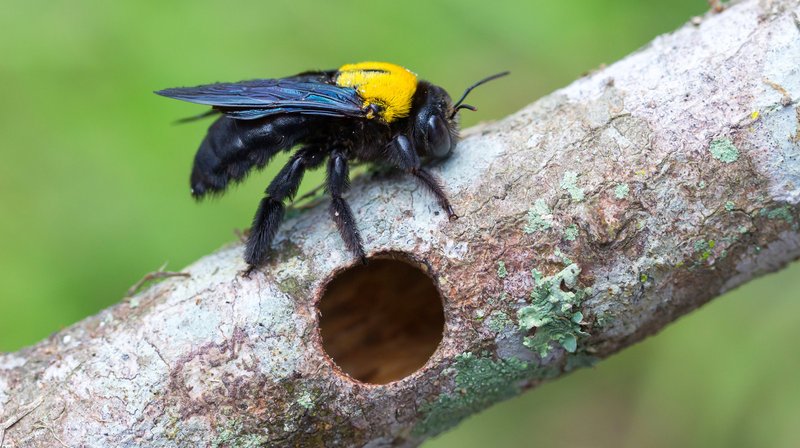
Carpenter bees are fascinating insects, not just because of their size but also due to their crucial role in pollination. These bees are known for burrowing into wood, which can sound a bit alarming at first. But fear not; they’re not out to destroy your garden. In fact, they can significantly benefit your flowers, fruits, and veggies. So, how do you go about inviting them over for a visit? Let’s dive into some easy and effective ways to make your garden a carpenter bee haven!
Understanding Carpenter Bees
Before we jump into attracting them, let’s get to know carpenter bees a bit better. These large, fuzzy bees resemble bumblebees but have a shiny, hairless abdomen. You might be wondering, “Why do they burrow into wood?” Well, carpenter bees are named for their unique burrowing behavior. They create tunnels in untreated wood to lay their eggs. It sounds destructive, but it actually doesn’t harm sturdy structures unless they’re left untreated.
Carpenter bees are solitary creatures, which means they don’t live in hives like honeybees. This can make them a great neighbor in your garden since they won’t swarm like their hive-living counterparts. Their primary goal is to gather pollen and nectar. As they flit from flower to flower, they play an essential role in pollination, making your garden bloom even brighter!
Create a Bee-Friendly Environment
To attract carpenter bees, you’ll need to create a welcoming environment. These bees love brightly colored flowers. Think of colors like yellow, blue, and purple. Planting a variety of flowering plants not only invites these bees but also creates a vibrant, beautiful garden. Here are some plants they particularly love:
- Lavender
- Bee balm
- Sunflowers
- Wildflowers
- Black-eyed Susans
Here’s the thing: the more diverse your garden’s plant life is, the better! Providing a range of shapes and sizes of flowers will help attract different pollinators, including carpenter bees. You might also consider planting in clusters rather than spacing them out. This way, the bees can easily find their favorite flowers and get right to work!
Leave Some Wood Unfinished
If you want to roll out the welcome mat for carpenter bees, consider leaving some untreated wood in your garden. They prefer soft wood that they can easily tunnel into. If you have old tree stumps, wooden fences, or garden furniture that are untreated, you might just have the perfect invite for these bees.
Remember, carpenter bees are not looking to damage your home; they prefer wood that is naturally weathered and soft. If you don’t have any untreated wood available, you can also use wooden blocks or posts. Just make sure they’re not painted, as bees won’t be interested in tunneling through paint or treated wood.
Provide Nesting Options
Why not help carpenter bees find a cozy home? You can easily create nesting habitats for them. One popular method is to drill holes into untreated wooden blocks or logs. Aim for holes that are about ½ inch in diameter and around 6 inches deep. This mimics their natural nesting habits and encourages them to settle down in your garden.
Place these blocks in a sunny spot, as carpenter bees prefer warm, sunny areas. And don’t worry if your efforts attract other beneficial insects—more guests usually mean a more vibrant ecosystem in your garden! If nesting boxes don’t sound like your thing, just remember to avoid sealing off any existing holes in wood structures, as this can discourage them from returning.
Use Native Plants
Another fantastic way to attract carpenter bees is by incorporating native plants into your garden. Native flowers are already adapted to your local environment, making them easier for bees to access and thrive. Plus, these plants are often better at attracting native bees, which boosts the overall health of your local pollinator population.
Consider researching what flowers are native to your area. When selecting plants, opt for those with open, flat landing spots, as carpenter bees prefer to easily land and gather pollen. And as a bonus, native plants typically require less maintenance, making your gardening efforts more effortless!
Reduce Pesticide Use
Here’s the thing: while you want your garden to flourish, using pesticides can be harmful to carpenter bees and other beneficial pollinators. Try to avoid chemical pesticides and herbicides altogether. Instead, opt for natural pest control methods. For example, using ladybugs or nematodes can help keep pests at bay without harming the bees.
If you absolutely must use pesticides, do so in the evening when bees are less active. This way, you’ll minimize any negative impact on their population. Remember, a thriving ecosystem starts with protecting the bees that help your plants flourish!
Observe and Enjoy
Once you’ve created the perfect environment for carpenter bees, sit back and enjoy the show. Observing these gentle giants in action is not only fun but also rewarding. You might see them busily buzzing from flower to flower, helping to pollinate your garden as they go.
It’s fascinating to think about the role they play in your garden’s ecosystem. They’re not just there for your enjoyment; they’re working hard to ensure your plants grow and thrive. Make sure to take time to appreciate their efforts, and you’ll quickly find yourself smiling at the pollination magic happening right before your eyes.
Wrap-Up
Attracting carpenter bees to your garden is a rewarding experience that brings numerous benefits to your plants and local ecosystem. By creating a welcoming environment with beautiful blooms, untreated wood, and native plants, you can invite these incredible pollinators into your space. Remember to keep your garden chemical-free and consider adding nesting options for them to settle in.
With a little patience and care, you’ll soon find that your garden is buzzing with life thanks to these charming carpenter bees. Not only will they help your plants, but they’ll also enhance the beauty and biodiversity of your outdoor space. Happy gardening!

